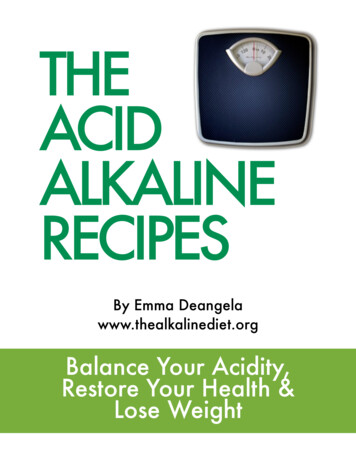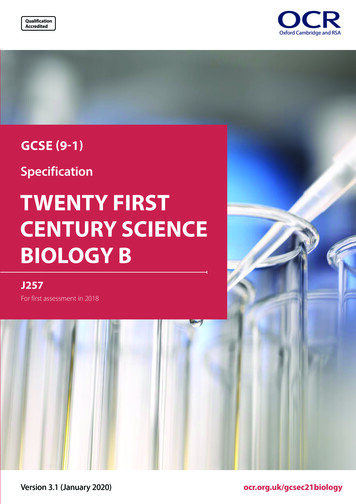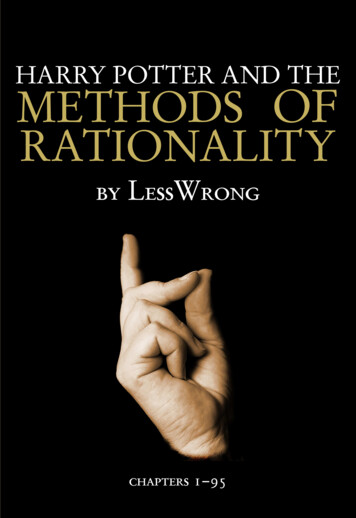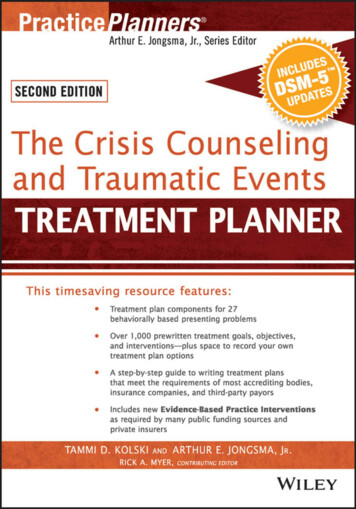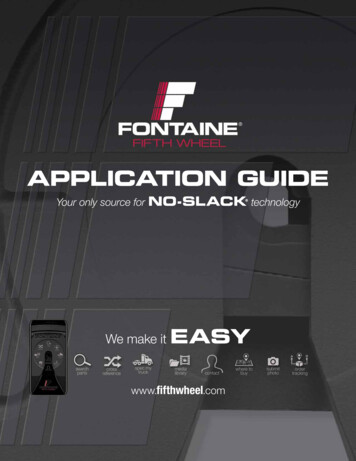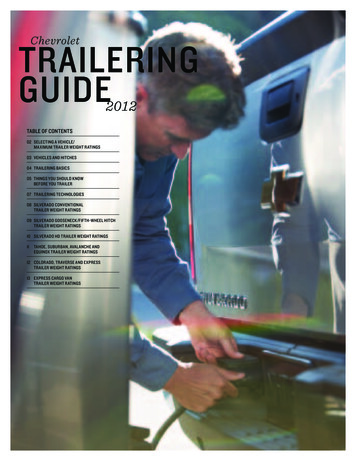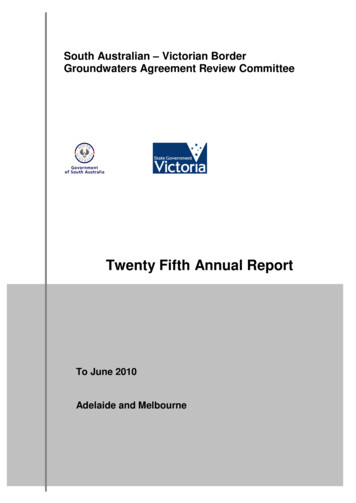
Transcription
South Australian – Victorian BorderGroundwaters Agreement Review CommitteeTwenty Fifth Annual ReportTo June 2010Adelaide and Melbourne
Managing groundwater resources across the South Australian – Victorian borderThe Border Groundwaters AgreementBorder Groundwaters Agreement Review CommitteeTwenty Fifth Annual Report – To 30 June 2010PAGE 2
Managing groundwater resources across the South Australian – Victorian borderThe Border Groundwaters AgreementPREFACEThe Border Groundwaters Agreement Review Committee‟s annual report for 2009-10 fulfilsthe requirement under clause 30(1) of the Border Groundwaters Agreement to report on itsactivities during the year to 30 June 2010. This report has been compiled with reference toreports from South Australia and Victoria.Clause 30(2) requires the Review Committee to forward a copy of the report to theappropriate Minister in each Government.Section 11 of the Victorian Groundwater (Border Agreement) Act 1985, and Section 13 of theSouth Australian Groundwater (Border Agreement) Act 1985 provides that the relevantMinister shall cause a copy of the annual report to be laid before the Parliament withinfourteen sitting days of the receipt of the report.Border Groundwaters Agreement Review CommitteeTwenty Fifth Annual Report – To 30 June 2010PAGE 3
Managing groundwater resources across the South Australian – Victorian borderThe Border Groundwaters AgreementBorder Groundwaters Agreement Review CommitteeTwenty Fifth Annual Report – To 30 June 2010PAGE 4
Managing groundwater resources across the South Australian – Victorian borderThe Border Groundwaters AgreementTABLE OF CONTENTS1.2.The year in summary7Province 17Province 28Province 38About the Agreement and the Review Committee9The Border Groundwaters Agreement9Border Groundwaters Agreement Review Committee3.4.10General Information11Groundwater resources in the South Australian – Victorian border regions11Management approach11Permissible Annual Volumes, Allocations and Volumes Extracted14Permissible Distance from the border17Permissible Potentiometric Surface Lowering18Permissible Salinity18Adjustments to Permissible Annual Volumes and Available Annual Volumes18Reports from the States21Funding22FIGURES23Figure 1 The Designated Area and zones23Figure 2 Hydrogeological provinces24Figure 3 Schematic hydrostratigraphic cross-sections25Figure 4 Relationship of other management areas in Victoria and South Australia to theDesignated Area26Figure 5 Map of long term groundwater level trends for the Tertiary Limestone Aquifer27Figure 6 Map of long term groundwater level trends for the Tertiary Confined Sand Aquifer 28Figure 7 Maps of Sub-division of Zones 1A, 6A and 9A29GLOSSARY30REFERENCES31APPENDICES32Border Groundwaters Agreement Review CommitteeTwenty Fifth Annual Report – To 30 June 2010PAGE 5
Managing groundwater resources across the South Australian – Victorian borderThe Border Groundwaters AgreementBorder Groundwaters Agreement Review CommitteeTwenty Fifth Annual Report – To 30 June 2010PAGE 6
Managing groundwater resources across the South Australian – Victorian borderThe Border Groundwaters Agreement1.The year in summaryAlong the South Australian – Victorian border, groundwater is the only reliable water source.It is used extensively in both States for irrigation, industry use and urban water supply, aswell as farm stock and domestic use.While groundwater supplies are relatively secure for the short term, the Border GroundwatersAgreement Review Committee (Review Committee) has sought to improve the technicalunderstanding and management responses affecting the ongoing sustainable and equitableuse of groundwater, critical to the region‟s economy.Long-term declines in groundwater levels have occurred in many locations in Province 1 and2 of the Designated Area. Some stabilisation may be emerging in some areas of Province 1.The following sections identify key aspects for each of the three Provinces within theDesignated Area:Province 1The Tertiary Limestone Aquifer1 is a high yielding and renewable resource and is replenishedby rainfall. Parts of Province 1 are experiencing long-term declines in groundwater levels inboth the Tertiary Limestone Aquifer and the Tertiary Confined Sand Aquifer.2 The system isnot in balance as outflows and extractions exceed inflows.The use of the water includes licensed extractions for irrigation and other purposes, and thedirect interception and extraction by plantation forests. The generally drier conditions sincethe mid 1990s are also contributing to the declines. Without a change in the current land andwater use, these declines will continue over parts of Province 1 unless there is a significantincrease in rainfall over a number of years.The Review Committee proposed to the States that a new management approach is neededin Province 1 to achieve long-term sustainability (BGARC 2008). This is likely to require areduction in the area under plantation forestry and a reduction in the volume of groundwaterextracted. The most significant deficiency in the current management arrangements is thatthe Border Groundwaters Agreements (the Agreement) does not account for the impacts ofplantation forests on the groundwater resource. The Review Committee proposed that theStates develop a consistent approach to account for the water used by plantation forests inthe Designated Area. Both States are addressing this issue. South Australia has a regulationand accounting process to manage the impacts of new plantation forests in the lower SouthEast of the State. In Victoria, the issue of plantation forest water accounting andmanagement is being canvassed through the process to prepare the Western RegionSustainable Water Strategy.The Review Committee is overseeing a joint South Australian-Victorian study funded by theNational Water Commission to determine the nature of the interaction between the TertiaryLimestone Aquifer and the Tertiary Confined Sand Aquifer in Province 1. The connectionbetween the aquifers is of interest because the declines in groundwater levels occurring in1The Tertiary Limestone Aquifer is generally the Gambier Limestone in the Otway Basin and the MurrayGroup Limestone in the Murray Basin (Figure 3)2The Tertiary Confined Sand Aquifer is the Dilwyn Formation in the Otway Basin and the Renmark Groupin the Murray Basin (Figure 3)Border Groundwaters Agreement Review CommitteeTwenty Fifth Annual Report – To 30 June 2010PAGE 7
Managing groundwater resources across the South Australian – Victorian borderThe Border Groundwaters Agreementthe Tertiary Confined Sand Aquifer are similar to those observed in the Tertiary LimestoneAquifer even though there is very little extraction of water from the Tertiary Confined SandAquifer. The previous understanding is that the aquifers were not connected. This projectwill involve drilling bores and undertaking pumping tests to determine the relationshipbetween the two aquifers. The study is due for completion by March 2012 and the results willinform future South Australia - Victoria border groundwater sharing agreements andlicensing.Province 2The Tertiary Limestone Aquifer groundwater in Province 2 is not being significantlyreplenished by modern recharge and for water allocation and management purposes itshould be considered a non-renewable resource. Groundwater level declines are stillcontinuing in some areas.In 2007, the Review Committee completed a review of the groundwater resource in Province2 and recommended that the States develop a policy for the management and use of theresource on the basis that it is non-renewable. Victoria is developing a management strategyfor the West Wimmera based on the understanding that the resource is non-renewable. TheReview Committee, in consultation with all the relevant regional management authorities, iscurrently scoping a process to consider managing the groundwater resource as a nonrenewable resourceSouth Australia revised its water allocation plan for the Tatiara Prescribed Wells Area whichcovers part of Province 2. The plan incorporates the conversion of the area based irrigationallocations to volumetric entitlementsProvince 3The groundwater in Province 3 is not being replenished by modern recharge and has beenmanaged as a non-renewable resource since 2001.The Review Committee‟s management review, Management Tertiary Limestone Aquifer inProvince 3 of the Designated Area, was completed in January 2010. Overall the TertiaryLimestone Aquifer appears to have responded as previously anticipated in respect todrawdowns and salinity. The Committee has recommended to the States that the currentmanagement arrangements continue for the time being. No amendments to the managementprescriptions are recommended.South Australia is revising its water allocation plan for the Mallee Prescribed Wells Areawhich covers part of Province 3. The draft plan proposes a conversion of the area basedirrigation allocations to volumetric entitlements.Border Groundwaters Agreement Review CommitteeTwenty Fifth Annual Report – To 30 June 2010PAGE 8
Managing groundwater resources across the South Australian – Victorian borderThe Border Groundwaters Agreement2.About the Agreement and the Review CommitteeThe South Australian –Victorian Border Groundwaters AgreementThe groundwater resource along the South Australian – Victorian border is shared betweenboth States. In recognition of the need to cooperatively manage these resources, the twoStates entered into the Border Groundwaters Agreement (the Agreement) in 1985. TheAgreement was updated in 2006, but both States have now agreed to a full review of theAgreement and its operation.The Agreement establishes a Designated Area, extending 20 kilometres either side of theborder, and from the coast to the River Murray. The Agreement applies specifically to thisDesignated Area. The Designated Area is divided into 22 management zones with 11 zonesin each State (Figure 1).The Agreement provides that the available groundwater shall be shared equitably betweenthe two States and applies to all existing and future bores within the Designated Area, exceptdomestic and stock bores.Extraction licences or permits may not be granted or renewed within the Designated Areaother than in accordance with the management prescriptions set out in the Agreement. Theprescriptions limit water use to a Permissible Annual Volume for total withdrawals from allaquifers or each aquifer, to a permissible rate of potentiometric surface lowering, and to apermissible level of salinity. The prescriptions also provide that, where appropriate, casing ofnew wells shall be sealed between aquifers to prevent inter-aquifer contamination.The allocation of water is the responsibility of the licensing agencies in each State, inaccordance with the relevant groundwater management plan or water allocation planprepared under the States‟ respective water resources legislation.The approach taken by the States in developing management plans has included objectivesto better quantify the resource, to establish appropriate mechanisms for allocating theresource or, if needed, to restrict the use of the resource. Plans are developed throughconsultative committees to maximise community and industry involvement in making andimplementing the arrangements.The management areas relevant to the Designated Area are set out in Table 1. The locationsof the areas are shown in Figure 4.Table 1 Management areas relevant to the Designated AreaSouth AustraliaLower Limestone Coast Prescribed Wells AreaTatiara Prescribed Wells AreaMallee Prescribed Wells AreaNoora Prescribed Wells AreaBorder Groundwaters Agreement Review CommitteeTwenty Fifth Annual Report – To 30 June 2010VictoriaMurrayville Water Supply Protection AreaNeuarpur Water Supply Protection AreaGlenelg Water Supply Protection AreaWest Wimmera Groundwater Management Area(proposed)PAGE 9
Managing groundwater resources across the South Australian – Victorian borderThe Border Groundwaters AgreementBorder Groundwaters Agreement Review CommitteeThe Review Committee, with membership from both States, is established under the BorderGroundwaters Agreement as the operating body for the effective implementation andadministration of the Agreement.The Review Committee is required at intervals of not more than five years to review themanagement prescriptions – that is, the Permissible Annual Volume, the Allowable AnnualVolume for sub-zones, the permissible distance, the permissible rate of potentiometricsurface lowering (drawdown) and the permissible level of salinity (if any such levels havebeen declared).The Agreement provides that the Review Committee shall have the power to alter thepermissible distance, Permissible Annual Volume, Allowable Annual Volume, and to declarea period of restriction. The relevant State Ministers have the power to alter the permissiblerate of potentiometric surface lowering and the permissible level of salinity, on therecommendation of the Review Committee.The Agreement provides that the Review Committee may also: coordinate, or cause to be carried out, surveys, investigations and studies concerningthe use, control, protection, management or administration of the groundwater in theDesignated Area; make recommendations to the Contracting Governments or to any authority, agencyor tribunal of the Contracting Governments concerning any matter which, in theopinion of the Review Committee, may in any way affect the investigation, use,control, protection, management or administration of the groundwater within theDesignated Area; and review the Agreement and, if in its opinion, amendments thereto are necessary ordesirable, make recommendations to the Contracting Governments accordingly.The Review Committee met seven times during the year:26 August 200910 September 200929 October 200912 February 201015 April 201023 June 201029 June 2010MelbourneTeleconferenceAdelaideMelbourneMount GambierAdelaideTeleconferenceDuring the year membership of the Review Committee comprised:South AustraliaMr N PowerMr H HoptonMs B Cohenmembermemberdeputy memberVictoriaMr R NottDr J CookeMr M Burnsmembermemberdeputy memberMr R Nott was President until February 2010 when Mr N Power assumed the position. Ms ENelson and Mr D Harvey have provided executive officer support to the Review Committee.Border Groundwaters Agreement Review CommitteeTwenty Fifth Annual Report – To 30 June 2010PAGE 10
Managing groundwater resources across the South Australian – Victorian borderThe Border Groundwaters Agreement3.General InformationGroundwater resources in the South Australian – Victorian border regionsThere are two main aquifer systems along the state border comprising the Tertiary ConfinedSand Aquifer and the overlying Tertiary Limestone Aquifer (Figure 3). A thin Pliocene SandsAquifer may overlie the Upper Tertiary Aquitard.The Tertiary Limestone Aquifer is the principal source of groundwater throughout theDesignated Area, with water being used for a range of purposes – municipal supplies fortowns such as Mount Gambier, individual domestic and stock water supplies, industry andirrigation of agricultural crops and recreational grounds.Groundwater salinity in the Tertiary Limestone Aquifer is mostly less than 3000 ECU (about1800 mg/L TDS) in the Designated Area, except in the far north where it exceeds 30,000ECU (about 18,000 mg/L TDS).In the Designated Area, the Tertiary Limestone Aquifer has been sub-divided into threehydrogeological provinces as shown in Figure 2 and described below:Province 1 occurs largely in the Otway Basin and is characterised by Quaternarycalcareous sandstone overlying the Tertiary Limestone Aquifer (Gambier Limestone)forming one unconfined aquifer system;Province 2 is located in the Murray Basin where the Tertiary Limestone Aquifer(Murray Group Limestone) is unconfined and either outcrops at the surface, or isoverlain directly by the Pliocene Sands Aquifer; andProvince 3 is in an area of the Murray Basin where the Tertiary Limestone Aquifer(Murray Group Limestone) is confined by the Upper Tertiary Aquitard. A thin PlioceneSands Aquifer can overlie the Upper Tertiary Aquitard.Management approachIn accordance with its role to advise the States, as outlined in the previous section, theReview Committee has taken the following management approach for each Province.Tertiary Limestone Aquifer - Province 1The Tertiary Limestone Aquifer is a high yielding and renewable resource and is replenishedby rainfall. Parts of Province 1 are experiencing prolonged declines in groundwater levels, inboth the Tertiary Limestone Aquifer and the Tertiary Confined Sand Aquifer. The system isout of balance in that the outflows and extractions exceed inflows.The use of the water includes both extractions for irrigation and other purposes underlicence, and interception and extraction by plantation forests. Groundwater extraction fromshallow water tables by plantation forests is likely to be factor in the groundwater leveldeclines. The drier conditions since the mid 1990s are also contributing to the declines.Without a change in the current land and water use, these declines will continue over parts ofProvince 1.The Review Committee proposed to the States that a new management approach is neededin Province 1 to achieve long-term sustainability (BGARC 2008). Achieving a sustainableBorder Groundwaters Agreement Review CommitteeTwenty Fifth Annual Report – To 30 June 2010PAGE 11
Managing groundwater resources across the South Australian – Victorian borderThe Border Groundwaters Agreementlevel of extraction will likely require reductions in the area under plantation forests and thevolume extracted via bores. The most significant deficiency in the current managementarrangements is the non-accounting for the extraction impacts of plantation forest ongroundwater resources.The Agreement is silent on accounting for the impacts of land use change on groundwaterresources. The Review Committee noted South Australia has included the impacts ofplantation forest on groundwater resources in the lower South East in its groundwatermanagement approach where the impacts of new plantation forests are accounted for andmanaged in Province 1 and the southern portion of Province 2. This has been the casesince 2004 for the management of recharge impacts, and since 2007 for the extraction ofwater from shallow water tables by plantations.The Review Committee noted Victoria did not account for, or manage, the impacts ofplantation forests on water resources.The Review Committee proposed that the States develop a consistent approach to accountfor the water used by plantation forestry in the Designated Area. The Review Committeerecommended that, in the meantime, the current moratoriums on the issue of newgroundwater extraction licences be retained.Sea water intrusion appears to have occurred in the Tertiary Limestone Aquifer in Sub-zone1A South as groundwater salinity approximating that of seawater has been detected. TheSub-zone 1A South is considered to be at an increased risk from sea water intrusion ifgroundwater extractions increase. The Review Committee has divided Zone 1A into twosub-zones to help prevent any further intensification of extractions in Sub-zone 1A South.Setting an Allowable Annual Volume for the southern sub zone allows for the transfer ofentitlements out of the risk area to the northern sub-zone.Tertiary Limestone Aquifer - Province 2The Tertiary Limestone Aquifer in Province 2 is not being significantly replenished by modernrecharge and as such is considered non-renewable for water allocation and managementpurposes. This is evidenced by the observed declines in groundwater levels of approximately0.2m/yr since 1996 in the area of concentrated extractions in Zones 5A, 6A, 5B and 6B.While these declines in groundwater levels appear to be manageable, with respect to thecapacity of the resource in the short term, the Review Committee has advised the States ofthe need to develop a common policy for the long-term management and use of groundwateron the basis that this is a non-renewable resource (BGARC 2007). The Review Committeedetermined to cap allocations as a precaution against further declines, in the meantime.The Permissible Annual Volumes for Zones 7A, 7B, 8A, and 8B were reduced to theallocated volumes for each zone at that time.The southern area of Zone 6A is experiencing a continuing trend of a declining water table.The Committee established a sub-zone in Zone 6A. Sub-zone 6A South was established withan Allowable Annual Volume at the level of current allocations. Transfers of entitlement canbe made away from the impacted or threatened area, but the volume of allocations allowedin the sub-zone are capped at current allocations, allowing transfers out of the sub–zone.There is no change to the Permissible Annual Volume for Zone 6A.The Review Committee, in collaboration with the States and the regional water managementauthorities, is scoping a process by which the potential for a common policy approach acrossthe state border for managing the groundwater resources of the Province 2 TertiaryLimestone Aquifer will be investigated.Border Groundwaters Agreement Review CommitteeTwenty Fifth Annual Report – To 30 June 2010PAGE 12
Managing groundwater resources across the South Australian – Victorian borderThe Border Groundwaters AgreementTertiary Limestone Aquifer - Province 3This groundwater is not being replenished by modern recharge and has been managed as anon-renewable resource since 2001.The Review Committee‟s Management Review Tertiary Limestone Aquifer in Province 3 ofthe Designated Area was concluded in January 2010 and the States were advised of the keyrecommendations.In summary, the Tertiary Limestone Aquifer appears to have responded as expected to thelevel of use, in terms of drawdown and salinity. The full potential response of the aquifer isyet to be realised as groundwater extraction in Victoria has been less than PermissibleAnnual Volume. Further drawdown in groundwater levels are anticipated when groundwaterextractions increase.The Committee‟s view is that there is no immediate risk of increased groundwater salinitydue to either the lateral movement of saline groundwater or the vertical leakage of salinewater from the Pliocene Sands Aquifer. There is a need to continue to monitor salinity in theaquifer.There is potential for localised increased drawdown, which if developed would impact on theusers of groundwater for domestic and stock groundwater purposes, increase the risks ofpartial dewatering of the aquifer or accelerating water quality change. The Committeerecommended that States enhance measures to prevent uncontrolled localised drawdownarising from intense groundwater extraction.The continuations of the present volumes of extractions, for the next 5 to 10 years, will notcompromise the quality and availability of this resource. Consequently no amendments arerequired to the management prescriptions.The water level and salinity monitoring networks are considered sufficient, although theReview Committee recommended enhancing the observation bore network by placing a boreor bores in the Sunset Country in the south west part of Zone 11B.The South Australian Government is undertaking a program to convert water licences fromarea based to volume based. The Committee supports this process. At the request of SouthAustralia, Permissible Annual Volumes for Zones 9A, 10A and 11A, were realigned inpreparation for the proposed new water allocation plan for the region. The sum of thePermissible Annual Volumes for the three Zones remained the same. In addition to theconversion of allocations to volumetric entitlements, the new water allocation plan is intendedto incorporate a transfer policy to ensure there is no further concentration of extractions atareas considered to be at risk of water level decline.Tertiary Confined Sand AquiferManagement prescriptions for the Tertiary Confined Sand Aquifer in the Designated Arearemain unchanged since 2001. The volumes available for allocation are based on aproportion of through flow. Due to the extensive regional nature of the Tertiary ConfinedSand Aquifer and its hydraulic behaviour, the States extended the approach applied in theDesignated Area to the whole aquifer system outside of the Designated Area.Pliocene Sands AquiferThe Pliocene Sands Aquifer overlies the Tertiary Limestone Aquifer in the Murray Basin. Thisis a significant feature in Zone 11A. The groundwater in the Pliocene Sands Aquifer isgenerally saline in the part of the aquifer within the Designated Area. In 2007, the ReviewBorder Groundwaters Agreement Review CommitteeTwenty Fifth Annual Report – To 30 June 2010PAGE 13
Managing groundwater resources across the South Australian – Victorian borderThe Border Groundwaters AgreementCommittee determined a Permissible Annual Volume for the Pliocene Sand Aquifer in Zone11A to provide for salinity mitigation extractions for the Murtho Salt Interception Scheme.Permissible Annual Volumes, Allocations and Volumes ExtractedThe Permissible Annual Volumes for each aquifer in each zone at 30 June 2010 are set outin Table 2.A number of changes were made to the prescriptions during the year and these a furtherexplained at the end of this section in Tables 9A, 9B and 9C.Table 2: Permissible Annual Volumes at 30 June 2010VictoriaSouth AustraliaPermissible Annual VolumePermissible Annual VolumePlioceneSands aryConfinedSand yr)TertiaryConfinedSand B1B182367205960676066009838 00510014500Note : Effective from 15 July 2010 the 6B Tertiary Limestone Aquifer Permissible Annual Volume is 10811 MLNote *: Effective from 15 July 2010 the 5B Tertiary Limestone Aquifer Permissible Annual Volume is 12201 MLAllocations and use for the Tertiary Limestone Aquifer, the Tertiary Confined Sand Aquiferand the Pliocene Sands Aquifer are listed in Tables 3, 4 and 5, respectively. Note that the„volume extracted‟ is the volume of groundwater extracted under a permit/licence and doesnot take into account the volume extracted for domestic and stock use or the impacts ofplantation forests. The Agreement does not apply to bores for domestic and stock purposes.Border Groundwaters Agreement Review CommitteeTwenty Fifth Annual Report – To 30 June 2010PAGE 14
Managing groundwater resources across the South Australian – Victorian borderThe Border Groundwaters AgreementTable 3: Permissible Annual Volumes, Volumes Allocated and Volumes Extracted forthe Tertiary Limestone Aquifer at 30 June 2010South AustraliaVictoriaTertiary Limestone AquiferTertiary Limestone AquiferLicensed 70014000ZoneLicensed eAllocated(ML)VolumeExtracted(ML)No. 09838156A149838 ote : Effective from 15 July 2010 the 6B Tertiary Limestone Aquifer Permissible Annual Volume is 10811 MLNote *: Effective from 15 July 2010 the 5B Tertiary Limestone Aquifer Permissible Annual Volume is 12201 MLTable 4: Permissible Annual Volumes, Volumes Allocated and Volumes Extracted forthe Tertiary Confined Sand Aquifer at 30 June 2010South AustraliaVictoriaTertiary Confined Sand 360540710190029009200Tertiary Confined Sand AquiferLicensed AllocationsZoneNo. r Groundwaters Agreement Review CommitteeTwenty Fifth Annual Report – To 30 June 605703001000510014500Licensed AllocationsNo. 0000000000000000000000000000000PAGE 15
Managing groundwater resources across the South Australian – Victorian borderThe Border Groundwaters AgreementTable 5: Permissible Annual Volumes, Volumes Allocated and Volume Extracted forthe Pliocene Sands Aquifer at 30 June 2010PermissibleAnnualVolume(ML/yr)2144South AustraliaPliocene Sands AquiferLicensed AllocationsVolumeVolumeNo. any of the zones are fully committed in the Tertiary Limestone Aquifer (Table 3), in that thevolumes licensed are approaching the Permissible Annual Volumes. Points of interestinclude:A moratorium on new licences and permanent transfers of groundwater entitlementsremains in place for Zones 1B to 9B under Victoria‟s water legislation.The recently adopted Tatiara Water Allocation Plan, which includes an area fromZone 7A to Sub-zone 9A South, includes transition provisions for irrigators to adapt tothe newly converted volumetric entitlements. This is through a stepped process thatresults in all the allowable volumes returning to the level of allocations existing whenthe water allocation plan was adopted. This level will be attained on 1 July 2012 afterthe initial temporary increase being made during 2009-2010 year.There is un-allocated water in Zone 2A, but this is held in the South AustralianMinister‟s reserve.No commitments of new water allocations were made during the year.The volume of groundwater extracted is similar or less than the extractions in theprevious year. The use does not exceed
Border Groundwaters Agreement Review Committee Twenty Fifth Annual Report - To 30 June 2010 PAGE 5 TABLE OF CONTENTS 1. The year in summary 7 Province 1 7 Province 2 8 Province 3 8 2. About the Agreement and the Review Committee 9 The Border Groundwaters Agreement 9 Border Groundwaters Agreement Review Committee 10 3.

